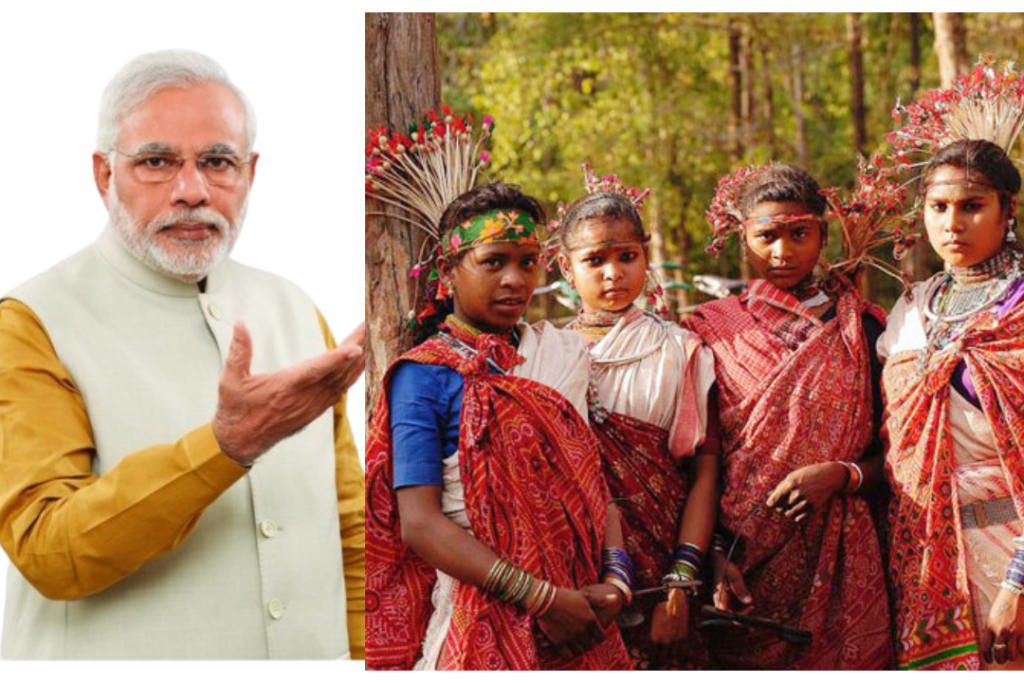
Pradhan Mantri Janjatiya Unnat Gram Abhiyan
Pradhan Mantri Janjatiya Unnat Gram Abhiyan, commonly abbreviated as PMJUGA, is one of the nationwide transformational initiatives led by the Government of India in a bid to meet the needs of the socio-economic development requirements of the tribal communities from all walks of India.
In pursuit of inclusive growth for the country, the scheme focuses on infrastructure, education, healthcare, and livelihoods in India’s tribal regions. PMJUGA covers more than 63,000 villages with substantial tribal populations and impacts nearly five crore (50 million) tribal people. It aims to make the tribal race more robust, reduce socio-economic inequalities in the country, and develop sustainable development for India’s remote corners.
Table of Contents
Aims of Pradhan Mantri Janjatiya Unnat Gram Abhiyan
Pradhan Mantri Janjatiya Unnat Gram Abhiyan has some core objectives that define its approach and anticipated outcomes:
1. Infrastructural and Connectivity Developments
Instead, the government aims to fill in infrastructure gaps, particularly roads and electricity, and in places, communication networks. Better connectivity helps tie up tribal villages to nearby towns and cities that can provide access to essential services-health and education as well as economic opportunities. The road infrastructure is to be improved with ease of access for commodities as well as services, which is critical for economic growth and social integration.
2. Development of Education and Skill Building
Education is one of the most prominent aspects of PMJUGA, as literacy rates in the tribal territories are usually low in comparison to the national average. This scheme encourages students to open schools and vocational training centers, and educational programs for upgradation and enhancement of literacy rates for employment avenues for tribal youth. In this way, the government tries to empower tribal communities with skills toward sustainable livelihoods.
3. Quality Healthcare Service
It focuses on the health needs under PMJUGA. Most tribal areas lack healthcare facilities, and for that reason, residents are facing problems from that health point of view. PMJUGA has planned to set up primary health care centers, improve maternal and child health services, increase vaccination coverage, and tackle preventable diseases. It also trains healthcare workers from the tribals in order to provide care that will be sensitive to the culture of the patients.
4. Livelihood Opportunities and Improving Economic Development
Economic empowerment is one of the key initiatives under the Pradhan Mantri Janjatiya Unnat Gram Abhiyan. Vocational education and training for minor and organic provide livelihood opportunities as well as employment. Sustainability is maintained by sustainable agriculture, animals, and handicrafts in order to support tribes to ensure their traditional bases alongside generating income.
5. Environmental Sustainability
Tribal people are in well contact with nature since they depend on natural resources. PMJUGA offers a platform for eco-friendly development practices and protects natural resources because their tendency re-forest, treat the land according to agricultural practices, and sustain biodiversity to cope up with culture heritage that should move forward with economic development.
Key Elements of Pradhan Mantri Janjatiya Unnat Gram Abhiyan
PMJUGA is a comprehensive scheme that has a number of elements on board to address every aspect of development in tribal areas, including:
Village-Level Governance: It takes up the promotion of village-level governance through the creation of local committees that can exercise and manage development projects. They ensure community-level participation and contribute towards their own accountability in enacting government schemes.
Empowerment of Women: Women are integral part of the tribal system as they involve themselves in agriculture and other handicraft besides managing the household work. PMJUGA has the aim to train women with economic skills, financial literacy, and employment on a self-earning method to uplift their socio-economic status.
Use of Digital Technology: PMJUGA makes use of digital technology for better governance and monitoring. Digitization of record or the progress of development projects shows the object of transparency in the delivery of benefits to the tribe.
Health Initiatives: Mobile health camps and telemedicine centres have been launched in far-flung corner areas of the district to enhance health care. Apart from this, a preventive healthcare awareness drive has been undertaken through the dissemination of information on hygiene and nutrition, which are the need of the hour for public health improvement in this region.
Implementation and Monitoring of PMJUGA
Pradhan Mantri Janjatiya Unnat Gram Abhiyan takes a decentralized route with local governance structures and community leaders. This, in reality, will be better identification of the specific needs of each village and will create a feeling of ownership among the people involved.
The scheme further employs a robust monitoring framework to ensure transparency and accountability. PMJUGA dashboard is availed to track real-time data on project performance, fund allocation, and benefits at the village, district, and state levels. This approach gives an early challenge recognition and an avenue to allow the government to take necessary corrective action.
Socio-Economic Impact of Pradhan Mantri Janjatiya Unnat Gram Abhiyan
The PMJUGA scheme is to be undertaken in a manner that will bring a complete change in the tribal population in India. The transformation to be brought in the tribal communities is listed below:
1. Improved Quality of Life: With improved infrastructure, health care, and educational infrastructure, this is what has been expected: tribal communities are going to see marked improvement in their quality of life. Sanitation, clean water, and other dependable healthcare services can reduce disparities and will provide the community with a healthy atmosphere to grow into.
2. Job Opening: The PMJUGA would promote industries, agriculture, and skill development, which means a lot of employment openings within tribal regions. This would limit migration to urban areas and will help in the growth of the local economy. Tribal people would be earning their livelihood within their communities.
3. Maintenance of Cultural Heritage: Tribal communities have developed mature cultural ethos through some unique art forms, handicrafts, and other practices. PMJUGA maintains the traditional practices for the handicraft by providing market access and preserving indigenous knowledge to support tribes’ culture identity and strengthen economic stability.
4. Poverty Alleviation: Employment possibilities and convenient availability of basic facilities provide simple channels through which the poverty levels among the people in the given tribal groups may be decreased. This further helps India in achieving its more significant objectives of removing poverty and socialization, and hence, it makes the tribal groups contribute to the socio-economic development of the country in full.
Challenges and Solutions for Pradhan Mantri Janjatiya Unnat Gram Abhiyan
Though the potential of PMJUGA is transformative, some issues remain to be surmounted:
Geographical Disadvantages: The remoteness of most tribal villages and its areas creates logistical difficulties in providing services. Against this, the scheme hails the omnipotence of digital technology and mobile service delivery units to attain the farthest corners.
Cultural Sensitivity: Sometimes cultural misfits are an outcome of implementing modern development projects in traditional communities. PMJUGA engages with local leaders to ensure that all the initiatives undertaken are culturally compatible and are in line with the values of the tribal communities.
Sustained Funding: The pros of the proper financing require sustainability over a long period for PMJUGA. The budgeting under the scheme is sure and the government consults with the NGOs and private stakeholders to secure unhampered financial assistance.
Conclusion: Step Towards Inclusive Development
Pradhan Mantri Janjatiya Unnat Gram Abhiyan is an integral component of Indian policy inwards inclusive development and bridging socio-economic inequalities in tribal communities.
The real goal of PMJUGA is to uplift the tribal population and integrate it into the nation’s growth story. It addresses issues as important as infrastructure, health, education, and livelihood opportunities.
This endeavor contributes to the social and economic empowerment of India’s tribes and fosters its rich cultural heritage and enriches environmental sustainability. Continued efforts and community engagement may make the Pradhan Mantri Janjatiya Unnat Gram Abhiyan one of the potent initiatives to transform tribal regions, with the potential to serve as a model of sustainable and inclusive development for future generations.
Read more: Pradhan Mantri Janjatiya Unnat Gram Abhiyan: Concept and Development of Tribal Development in IndiaPM – Surya Ghar: Muft Bijli Yojana – A new energy initiative for rural India 2024




2 thoughts on “Pradhan Mantri Janjatiya Unnat Gram Abhiyan: Concept and Development of Tribal Development in India”